
How to Lose Weight by Swimming?

Swimming is a diverse and effective workout that has several weight loss and fitness benefits. Contrary to high-impact workouts like jogging, swimming is a low-impact workout that is mild on the joints, making it an excellent choice for people who have injuries or joint difficulties.
Table of Contents
Introduction
In this detailed article, we will delve into the world of weight loss swimming and study numerous facets of this form of exercise. We will go through the benefits of swimming, different types of swimming strokes, how to plan swimming workouts for optimal results and helpful weight loss advice. You will be well-equipped to embark on a journey to lose weight by swimming and enhance your overall health and well-being with the advice and information presented in this article.

Prominent Benefits of Swimming
Swimming is a highly advantageous physical activity. Some of the most significant benefits of swimming are listed below.
- Burn Calories: Swimming is an excellent calorie-burning exercise. Swimming can burn up to 500–700 calories per hour, depending on your weight. The intensity of your activity and the style of swimming stroke you use influence the number of calories expended during a swimming session.
- Low Impact: One of the primary benefits of swimming is that it is low-impact. This makes it an ideal exercise for anyone who has joint pain or is recuperating from accidents. Swimming allows you to be active without putting undue strain on your body.
- Enhance Endurance: Swimming is an excellent approach to increasing your endurance levels. Swimming more frequently will enhance your stamina and ability to swim for extended periods of time without weariness. Increased endurance leads to burning more calories and losing weight faster.
- Tone Muscles: Swimming provides a full-body workout that engages multiple muscle groups. Swim strokes target different muscles, helping you to tone and build your entire body. You can train different muscle groups and develop a well-rounded body by including a range of strokes in your swimming regimen.
Swimming Stroke Types
There are several popular stroke types in swimming. A few of the most popular ones are listed below.

- Freestyle (Front Crawl): The most common swimming stroke and a good choice for weight loss is freestyle. It is a fast-paced stroke that works several muscle groups at the same time. Depending on your weight and the intensity of your training, freestyle swimming can burn 500–700 calories per hour.
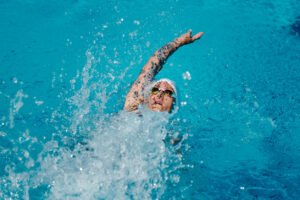
- Backstroke: Another beneficial weight-loss stroke is the backstroke. It mostly targets the muscles in your back and aids in the improvement of your posture. Swimming backstroke for an hour can burn between 400 and 500 calories, depending on your weight and workout intensity.
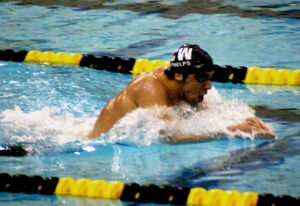
- Breaststroke: Breaststroke is a slower-paced stroke that many novices like. It concentrates on the chest, shoulders, and thighs. Swimming breaststroke for an hour can burn between 300 and 400 calories, depending on your weight and intensity.
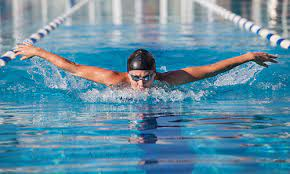
- Butterfly: The butterfly stroke is a difficult swimming stroke that focuses on the upper body muscles such as the chest, shoulders, and arms. It is a difficult workout and can burn 500–600 calories per hour, depending on your weight and the intensity of your swimming session.
How to Plan Your Swimming Workouts for Weight Loss
Beginning a weight loss journey with swimming necessitates meticulous planning as well as a systematic and disciplined strategy. To begin your swimming-based weight loss program, take the following steps:
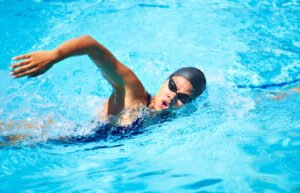
Step 1: Evaluate your present level of fitness and swimming abilities.
Determine your swimming ability and endurance, as well as any restrictions or concerns you may have, before beginning your journey to lose weight by swimming. Consider taking swimming lessons or speaking with a swim coach or teacher if you are unsure about your swimming abilities.
Step 2: Set attainable weight-loss objectives.
Determine how much weight you want to lose and when you want to attain your goals. Make sure your weight-loss objectives are both attainable and healthy. Consulting with a healthcare practitioner or a qualified dietician can help you set realistic goals.

Step 3: Plan your swimming schedule.
Plan your swimming exercises ahead of time to ensure consistency. Aim for three to four swimming sessions per week, at the very least, to lose weight by swimming. Determine the length of each session based on your current level of fitness and progressively increase it over time.
Step 4: Choose the appropriate swimming strokes.
Consider mixing up your swimming strokes in your sessions. Each stroke—freestyle, backstroke, breaststroke, and butterfly—has its own set of advantages and works with various muscle groups. During your swimming exercises, alternate between strokes to use your entire body and avoid boredom.
Step 5: Warm up Before each swimming session.
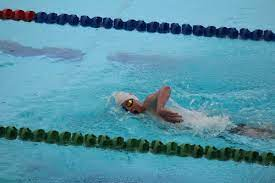
Begin with a five- to ten-minute warm-up of mild swimming, such as freestyle or backstroke, to warm up your muscles and raise your heart rate. This helps you avoid injuries and perform better throughout your primary workout.
Step 6: Plan your swimming exercises carefully.
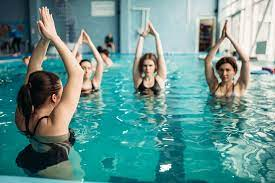
Incorporate interval training into your regimen by alternately swimming at high and low intensity. Swim a lap of freestyle at a demanding pace, then a lap of backstroke at a relaxed pace. As your fitness level improves, gradually increase the number of intervals to lose weight by swimming.
Step 7: Gradually increase swimming duration and effort.
Begin with shorter swim workouts and progressively increase the length as your endurance increases. Increase the intensity of your workouts over time to challenge yourself. This approach helps you burn more calories and lose weight.
Step 8: Maintain appropriate technique and form.

Maintaining proper swimming technique will help you get the most out of your exercises. This includes optimal body position, breathing, and stroke mechanics. Consultation with a swim coach or teacher might provide helpful advice on improving your form.
Step 9: Track your progress.
Keep track of your swimming exercises, including the distance traveled, length of time spent swimming and intensity. Assess your progress toward your weight loss objectives regularly and make necessary changes to your regimen.
Step 10: Complement your swimming for weight loss with a nutritious diet.

Remember that swimming helps with weight loss, but it alone will not result in weight loss. Adopt a balanced and nutritious diet that will help you achieve your calorie deficit goals. Consult a trained dietician for customized advice and suggestions.
Step 11: Stay hydrated and get enough rest.
Hydration is critical for swimming workout performance and recovery. Drink plenty of water before, during, and after your workouts. Also, make sure you have adequate rest and recuperation time so your body can mend and regenerate.
Step 12: Stay motivated and have fun with the process.
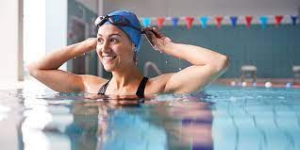
Maintain a positive attitude and keep yourself motivated throughout your weight-loss journey. Celebrate minor victories and enjoy the process of swimming and improving your fitness. Joining a swimming club or finding a swimming companion can provide additional support and incentive.
Step 13: Include resistance training workouts in your routine.
While swimming is a wonderful full-body workout, including strength training activities in your regimen will help you lose weight even more effectively. Resistance exercises, such as water aerobics or the use of water weights, can help build muscle strength while also increasing overall calorie expenditure. These exercises can be performed at the pool’s shallow end or during designated water aerobics programs.
Step 14: Consider doing high-intensity interval training (HIIT) workouts.
HIIT involves alternating short bursts of intensive swimming with active recovery intervals. This form of swimming helps with weight loss as it dramatically enhances your calorie burn while also improving your cardiovascular fitness. For example, you could swim as quickly as you can for 30 seconds, followed by a 1-minute slower-paced recovery swim. Repeat this cycle for the specified number of sets.
Step 15: Enroll in a swimming club or class.

Swimming in a group can provide additional inspiration, support, and accountability. Consider joining a swimming group, club, or class in your neighborhood or at your local pool. Engaging with others who share your goals and crucial insights on how to lose weight by swimming will make your weight loss journey more fun and help you stick to your swimming sessions.
Step 16: Monitor your progress and make any improvements.
Keep track of your swimming workouts, including the distance, time, intensity, and any other exercises you do. Evaluate your development regularly and make necessary changes to your program. If you hit a weight reduction plateau, try increasing the intensity or duration of your swimming workouts or introducing additional activities to challenge your body even more.
Step 17: Maintain consistency and include variety in your routines.
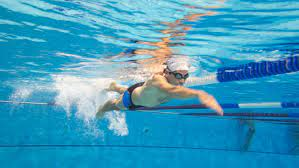
Weight loss through swimming requires consistency. Make swimming a part of your daily routine and commit to your scheduled sessions. In addition, make your workouts interesting by combining a variety of swimming strokes, intervals, and exercises. Variety not only keeps you from becoming bored, but it also keeps you targeting different muscle groups and challenging your body.
Step 18: Pay attention to your body and practice healthy recovery techniques.
Pay heed to your body’s cues and prevent overexertion or pushing yourself too hard too quickly. Include rest days in your swimming routine to allow for proper recovery. Adequate rest increases muscle regeneration, minimizes injury risk, and promotes long-term progress.
Keep in mind that consistency, patience, and perseverance are essential for attaining the long-term weight loss benefits of swimming. You can alter and challenge yourself further as you grow and adapt to your swimming program to continue enjoying excellent outcomes.
Note: There might be affiliate links mentioned here. We may receive a commission if you purchase a product through an affiliate link. There is no additional charge for you. Please do your own research before making any online purchases.
Weight Loss Success Strategies
There are several additional elements you can incorporate into your routine to boost weight loss while swimming. Here are some things you can do in addition to swimming to help you lose weight:
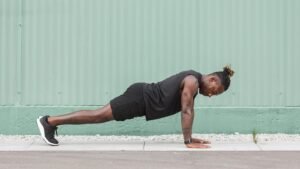
- Strength Training: Incorporating strength training exercises into your overall fitness routine can help you gain muscle mass and increase your metabolism. Lifting weights or bodyweight exercises, for example, can be performed on alternate days or non-swimming days. By gaining lean muscle, you increase your body’s ability to burn calories even when you’re not in the pool.
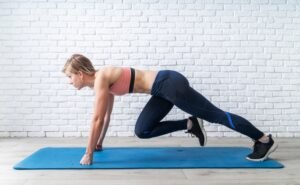
- Cardiovascular Exercises: In addition to swimming, consider including other cardiovascular exercises in your routine to increase calorie burn. Brisk walking, jogging, cycling, or using cardio machines such as an elliptical trainer or stair climber can supplement your swimming workouts. These exercises raise your heart rate and promote fat loss.
- High-Intensity Interval Training (HIIT): HIIT workouts consist of short bursts of intense exercise followed by short periods of rest. Incorporating HIIT into your routine, whether on land or in the water, can be extremely effective for weight loss. Interval training can be done by swimming sprints, alternating fast laps with slower recovery laps, or incorporating other high-intensity exercises like burpees or jumping jacks into your land-based workouts.

- Circuit Training: Circuit training combines cardiovascular and strength exercises into a series of stations or exercises that are performed sequentially. Alternate swimming laps with bodyweight exercises or use equipment such as resistance bands, medicine balls, or kettlebells to create a circuit. This method raises your heart rate, strengthens various muscle groups, and increases overall calorie burn.
- Flexibility and Mobility Training: Incorporate flexibility and mobility exercises into your program to improve your swimming performance and general fitness. Yoga, Pilates, and static stretching can help you increase your range of motion, minimize muscular imbalances, and prevent injuries. These exercises can be done separately or as part of your warm-up or cool-down routine.

- Active Lifestyle: Outside of structured exercise sessions, incorporate physical activity into your daily life. Take the stairs instead of the elevator, walk or bike short distances, or engage in recreational activities such as hiking, dancing, or sports. These modest lifestyle adjustments add up and help to increase your overall calorie expenditure, which aids in weight loss.
- Mindful Eating: Alongside physical activity, developing mindful eating practices is vital for weight loss. Pay attention to portion sizes, choose nutrient-dense foods, and prevent mindless snacking. Focus on incorporating a balanced diet consisting of lean proteins, whole grains, fruits, vegetables, and healthy fats. Consult a trained dietitian for individualized guidance on nutrition to assist your weight loss objectives.
- Monitoring Progress: Keep track of your swimming workouts, other exercises, and food habits to monitor your progress. Maintain a workout log or utilize fitness monitoring apps to record your activities, track your calorie burn, and evaluate your weight reduction. Regularly reviewing your progress allows you to make modifications and stay motivated on your weight loss quest.
FAQs
What makes swimming an effective workout for weight loss?
Swimming is excellent for weight loss due to its calorie-burning nature. Depending on parameters like intensity and stroke choice, you can burn up to 500–700 calories each hour. Its low-impact nature is mild on joints, making it excellent for people with ailments.
Swimming improves endurance and weight reduction in what ways?
Swimming develops endurance over time, allowing you to swim for longer periods of time without becoming fatigued. Increased endurance causes more calories to be burned, resulting in faster weight loss.
Swimming targets which muscles, and how does it help with toning?
Swimming utilizes multiple muscle groups, providing a total-body workout. Different strokes target different muscles. You can attain a well-rounded, toned physique by utilizing a variety of strokes.
What are the most important swimming strokes for losing weight?
Weight loss exercises include freestyle (front crawl), backstroke, breaststroke, and butterfly. Each stroke burns calories differently, giving you a range of workout possibilities.
How should I plan my weight-loss swimming workouts?
Assess your abilities, set realistic goals, plan a consistent schedule, choose various strokes, warm up, incorporate interval training, gradually increase duration and intensity, maintain proper technique, monitor progress, adopt a balanced diet, and ensure proper hydration and rest.
Can resistance training help me lose weight while swimming?
Yes, combining resistance training routines like water aerobics or utilizing water weights can help you lose weight by boosting muscle strength and calorie expenditure.
How may High-Intensity Interval Training (HIIT) be included in weight-loss swimming workouts?
HIIT involves alternating short bursts of intensive swimming with rest periods. This has the potential to greatly enhance calorie burn and cardiovascular fitness. Swim as fast as you can for 30 seconds, then do a slower-paced recovery swim for 1 minute.
Is it necessary to join a swimming club or class to lose weight?
Joining a swimming group or class can help you lose weight by providing inspiration, support, and accountability. It’s especially useful if you appreciate a sense of community and working toward common goals.
How can I stay motivated during my weight-loss swimming journey?
Celebrate minor victories, keep a good attitude, and enjoy the practice of swimming. Consider joining a swimming club or finding a swimming partner for extra support.
Are there any other factors that should be included in addition to swimming for efficient weight loss?
Yes, you may include strength training, cardiovascular workouts, flexibility and mobility training, mindful eating habits, and an active lifestyle into your routine to enhance weight loss. These components supplement swimming and improve general fitness.
Conclusion
Swimming is an excellent way to lose weight, improve cardiovascular health, and increase general fitness. Swimming as a type of exercise can provide a variety of benefits, including calorie burn, greater endurance, and muscular toning. Use the knowledge in this comprehensive guide to successfully arrange your swimming workouts using different strokes, intervals, and distances. In addition, follow the weight reduction suggestions for success, including eating a balanced diet, getting enough sleep, and being hydrated. You can unlock your potential and reach your fitness objectives by sticking to a consistent swimming regimen and taking a comprehensive approach to weight loss.
Disclaimer: The information provided in this article is for educational purposes only and should not be considered as a substitute for medical advice. Consult a healthcare professional before implementing any home remedies or making significant changes to your lifestyle.
